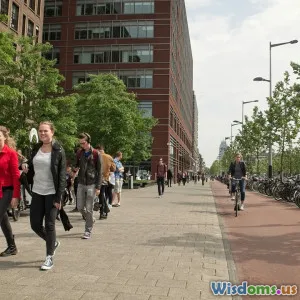
A Deep Dive Into Ride Sharing Apps Disrupting Traditional Taxi Economics
10 min read Explore how ride-sharing apps are transforming traditional taxi economics through technology, market dynamics, and consumer behavior. (0 Reviews)
A Deep Dive Into Ride Sharing Apps Disrupting Traditional Taxi Economics
Introduction
In the last decade, the rise of ride-sharing apps has revolutionized urban transportation, dramatically altering the economics of traditional taxi services. Instead of hailing cabs on busy streets or calling dispatch centers, millions now summon rides with a tap on a smartphone. This seemingly simple shift has rippled across markets, challenging established business models and even regulatory frameworks. But beyond the convenience lies a complex story of disruption, innovation, and economic transformation. Why and how have ride-sharing firms managed to reshape one of the most entrenched transportation sectors worldwide?
This article takes an in-depth look at the forces behind this seismic change. We will explore the technology, shifting consumer behavior, labor implications, pricing strategies, and regulatory battles that define the race between ride-sharing platforms and conventional taxis. By revealing these layers, readers will gain a nuanced understanding of how this new mobility ecosystem is redefining urban transit economics.
The Technological Edge: Platforms Transforming User Experience
Ride-sharing apps have thrived largely due to their advanced technology infrastructure. Platforms like Uber, Lyft, Didi, and Grab utilize GPS, real-time data analytics, and dynamic pricing algorithms to connect drivers and riders more efficiently than traditional taxi dispatch.
Real-Time Matching and Pricing
Unlike taxis that rely on fixed street availability or telephone dispatch, ride-sharing apps leverage smartphone GPS to provide immediate driver-rider pairing. This significantly reduces idle waiting times. According to Uber's data in 2019, average passenger wait times decreased from over 10 minutes with conventional taxis to under 5 minutes with their service.
Furthermore, dynamic pricing models, often called "surge pricing," allow apps to adjust fares based on demand fluctuations. While this model is sometimes controversial, it optimizes driver availability during peak hours and special events, balancing supply and demand more efficiently than static taxi fares.
Seamless Payments and Ratings
Cashless digital payments simplify the transaction process, eliminating disputes and enhancing user convenience. Additionally, mutual driver and passenger rating systems incentivize quality service, something traditional taxi hailing rarely implements.
These technological advances collectively elevate the user experience, offering transparency, reliability, and customization that legacy taxis struggle to match.
Economic Implications on Traditional Taxi Industry
The disruption goes beyond customer convenience. Ride-sharing apps challenge the very economics upon which taxi industries have historically relied.
License and Medallion Devaluation
Many cities cap the number of taxi licenses or medallions to regulate supply and maintain taxi driver income. In places like New York City, medallions once sold for over $1 million at their peak. However, following massive entry of ride-sharing competitors, medallion prices have plummeted by up to 70% between 2014 and 2020, causing significant wealth loss for medallion owners.
Pricing Pressure and Market Share
Lower operational costs for ride-sharing drivers — often independent contractors using personal vehicles — lead to cheaper rides overall. This cost advantage has enabled services like Uber to capture substantial market share, forcing taxis to lower prices or innovate to remain competitive.
For example, a 2018 MIT study revealed a 30% decline in traditional taxi rides in cities like Chicago and San Francisco, correlating closely with the growth of ride-sharing platforms.
Business Model Shift
Taxis typically operate under dispatch companies and drivers paying lease fees, while ride-sharing platforms function as marketplaces connecting drivers and riders independently. This shift lasers focus on variable costs and scalability but also introduces challenges related to driver labor stability.
Labor and Workforce Transformation
The human aspect of this disruption is visible in driver roles and conditions.
From Employees to Independent Contractors
Ride-sharing drivers are generally categorized as independent contractors rather than employees. This classification frees companies from providing benefits but ignites debates about worker rights and protections.
Income Volatility and Flexibility
Many drivers are attracted by the flexible hours and autonomy. However, earnings can be unpredictable due to dynamic pricing and competitive market pressures. Research from the Economic Policy Institute in 2020 indicated that ride-sharing drivers in the US earned approximately $11.77 per hour after expenses, which is near or below minimum wage in some regions.
Community Impacts
Interestingly, in many cities, ride-shares have lowered barriers for entry into driving jobs, diversifying incomes and work opportunities, but also sometimes saturate local markets leading to driver income decline.
Consumer Behavior and Urban Mobility Patterns
Ride-sharing has altered not only how rides are ordered but how people think about urban mobility altogether.
Modal Shift from Transit and Car Ownership
Studies have shown that in many cities, ride-sharing services have partly supplanted public transit trips and personal vehicle use. A 2019 report by the San Francisco County Transportation Authority found that 30-40% of Uber and Lyft trips replaced what would have been public transport or walking.
This shift raises sustainability concerns but also underscores the attractive convenience of on-demand services.
Expanded Mobility Options
For individuals unable to afford car ownership or those living in transit-poor areas, ride-sharing offers new access. Services focused on accessibility (including UberWAV with wheelchair-accessible vehicles) demonstrate attempts to broaden mobility inclusion.
Changing Expectations
Consumers increasingly expect frictionless, technology-integrated travel solutions. This has put pressure on traditional taxis and public transportation to innovate.
Regulatory Challenges and Responses
Regulators worldwide face difficult balancing acts responding to the new ride-sharing landscape.
Legal Disputes and Framework Variations
Governments have varied from enthusiastic adoption to outright bans. New York City implemented a cap on ride-sharing vehicles to reduce congestion, whereas other cities like London have imposed strict vehicle and driver standards.
Data Privacy and Fair Competition
Concerns about platform data usage, pricing transparency, and labor protections frequently arise. Legislation such as California’s AB5 attempted to reclassify drivers as employees but faces legal challenges.
Taxi Industry Protections and Modernization
In some areas, taxi lobbies have successfully pressured for fare parity laws and exclusive pickup zones, forcing ride-sharing firms to adapt.
Regulators continue to seek frameworks that embrace innovation without undermining worker rights or urban infrastructure sustainability.
Conclusion: Redefining Urban Transportation Economics
Ride-sharing apps are undeniably reshaping the economics of traditional taxi services through improved technology, new market dynamics, and evolving consumer expectations. While offering significant convenience and cost benefits to riders, they challenge incumbent taxi business models, labor realities, and regulatory paradigms in profound ways.
The journey ahead involves finding scalable solutions that balance innovation, fair labor practices, and sustainable urban planning. Traditional taxis must innovate theirs services and partnerships to remain competitive. Meanwhile, ride-sharing companies face growing scrutiny to ensure equitable treatment for drivers amid labor controversies.
Ultimately, this ongoing disruption also represents a remarkable example of how digital platforms can rewrite long-established industries, offering valuable lessons for future technological shifts in other sectors.
By understanding these interconnected factors—the technology, economics, labor, consumer trends, and regulation—stakeholders can better navigate the evolving landscape to foster mobility systems that benefit cities, workers, and riders alike.
Rate the Post
User Reviews
Popular Posts


















